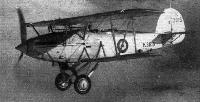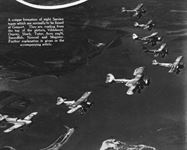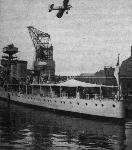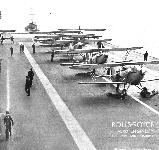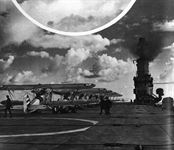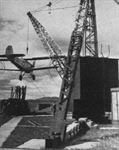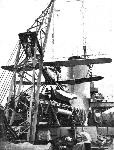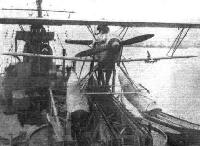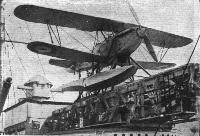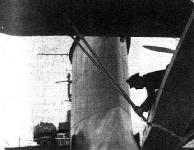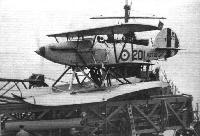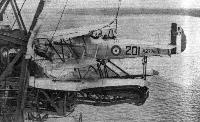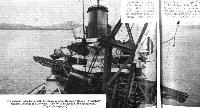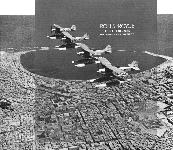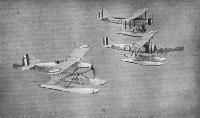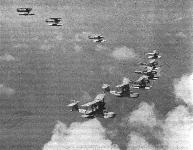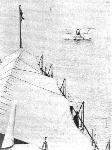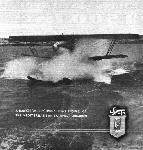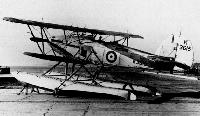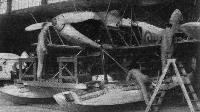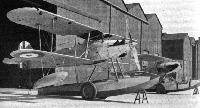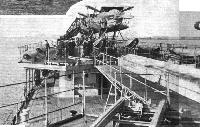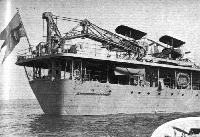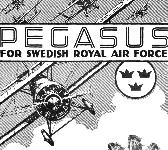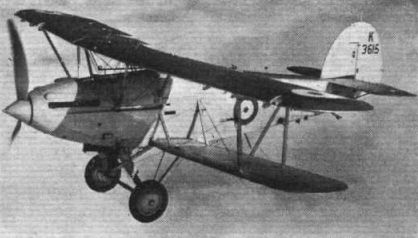
Описание
Страна : Великобритания
Год : 1930
Двухместный морской разведчик и корректировщик
Варианты
- Hawker - Hart - 1928 - Великобритания
- Hawker - Osprey - 1930 - Великобритания
- Hawker - Audax - 1931 - Великобритания
- Hawker - Demon - 1932 - Великобритания
- Hawker - Hardy - 1934 - Великобритания
- Hawker - Hind - 1934 - Великобритания
- Hawker - PV.4 - 1934 - Великобритания
- Hawker - Hartbees - 1935 - Великобритания
- Hawker - Hector - 1936 - Великобритания
Hawker Osprey
Самолет Osprey проектировался как двухместный морской корректировщик и разведчик. Он представлял собой фактически специальный морской вариант дневного бомбардировщика Hart. Прототип самолета, имевший складывающиеся крылья, усиленный фюзеляж и быстросъемное колесно-поплавковое шасси, совершил первый полет летом 1930 года. Первый серийный самолет Osprey Mk I поступил в эксплуатацию в ноябре 1932 года.
Osprey Mk II имел поплавковое шасси, a Osprey Mk III оснащался надувной спасательной лодкой, располагавшейся в верхнем крыле по правому борту. Все три этих варианта самолета оснащались двигателем Rolls-Royce Kestrel IIMS мощностью 630 л. с., но последняя модификация, Osprey Mk IV, получила двигатель Kestrel V. Самолеты семейства Osprey оставались в строевых частях до 1938 года, а затем еще два года эксплуатировались на второстепенных ролях и в тылу. Всего было построено 130 самолетов, из них часть машин были поставлены в Португалию (два самолета), Испанию (один) и Швецию (четыре).
ТАКТИКО-ТЕХНИЧЕСКИЕ ХАРАКТЕРИСТИКИ
Hawker Osprey Mk IV (сухопутный вариант)
Тип: двухместный морской разведчик и корректировщик
Силовая установка: один V-образный ПД Rolls-Royce Kestrel V мощностью 640 л. с. (477 кВт)
Летные характеристики: максимальная скорость на высоте 4000 м - 283 км/ч; крейсерская скорость на оптимальной высоте 175 км/ч; начальная скороподъемность 737 м/мин; набор высоты 3050 м - за 7 мин 40 с; практический потолок 7620 м; продолжительность полета 2 ч 15 мин
Масса: пустого 1545 кг; максимальная взлетная 2245 кг
Размеры: размах крыльев бипланной коробки 11,28 м; длина 8,94 м; высота 3,17 м; площадь крыльев 31,49 м2
Вооружение: один 7,7-мм пулемет Vickers Mk III слева в носовой части фюзеляжа и один 7,7-мм наводимый пулемет Lewis Mk III в задней кабине для обороны задней полусферы, плюс до 102 кг бомб на двух подкрыльевых узлах подвески
- Описание
Фотографии
-
Flight 1934-06 / Flight
Регистрационный номер: K3615 [5] Hawker "Osprey" (Rolls-Royce "Kestrel" II M.S.).
-
Flight 1935-06 / Flight
Регистрационный номер: K3615 [5] A two-seater, the "Osprey" uses a moderately-supercharged "Kestrel" of 525 h.p.
HAWKER OSPREY IV: Fleet fighter reconnaissance (Kestrel V engine - 640 h.p. at 14,000ft.); span, 37ft.; gross weight, 4,970 lb.; max. speed, 173 m.p.h. at 16,400ft. -
Flight 1936-01 / Flight Advertisements
Регистрационный номер: K3615 [5] The Hawker Osprey, Rolls-Royce Kestrel engine. The standard two-seater Fleet Fighter Reconnaissance machine of the Fleet Air Arm. There are both land and seaplane versions.
-
Flight 1935-12 / Flight
Регистрационный номер: K3615 [5] The Hawker Osprey is a two-seater fleet fighter with 600 h.p. Kestrel V engine.
-
Aeroplane Monthly 1994-12 / G.Wansbrough-White - What's in a name? (2)
A formation of eight types based at Gosport in 1938. They are, from the top, Vildebeest, Osprey, Shark, Tutor, Avro 504N, Swordfish, Nimrod and Magister. The 504N was flying at full bore while the Kestrels of the Nimrod and Osprey were throttled well back. Pilots of this “Heinz” formation were drawn from the RAF, Army, Navy and Marines; the aircraft came from the Coastal Defence Development Flight and the Torpedo Training Unit.
Другие самолёты на фотографии: Avro Avro 504N - Великобритания - 1920Avro Tutor/Sea Tutor/Prefect / Type 621/646/626 - Великобритания - 1929Blackburn Shark / B-6 - Великобритания - 1933Fairey Swordfish - Великобритания - 1934Hawker Nimrod - Великобритания - 1931Miles Magister / M.14 - Великобритания - 1937Vickers Vildebeest / Type 132 - Великобритания - 1928
-
Flight 1938-05 / Flight
A unique formation of eight Service types which are normally to be found at Gosport. They are, reading from the top of the picture, Vildebeest, Osprey, Shark, Tutor, Avro 504N, Swordfish, Nimrod and Magister.
Другие самолёты на фотографии: Avro Avro 504N - Великобритания - 1920Avro Tutor/Sea Tutor/Prefect / Type 621/646/626 - Великобритания - 1929Blackburn Shark / B-6 - Великобритания - 1933Fairey Swordfish - Великобритания - 1934Hawker Nimrod - Великобритания - 1931Miles Magister / M.14 - Великобритания - 1937Vickers Vildebeest / Type 132 - Великобритания - 1928
-
Aeroplane Monthly 1982-03 / Brooklands /Gone but not forgotten/ (12)
Регистрационный номер: S1677 [2] The prototype Hawker Osprey S1677 underwent trials with a landplane undercarriage at Brooklands in 1931/32.
-
Aeroplane Monthly 1984-07 / A.Lumsden, T.Heffernan - Probe Probare (5)
Регистрационный номер: S1677 [2] The deck-landing variant of the Hart was the Hawker Osprey two-seat carrier-borne seaplane fighter. It was available both as a landplane and a floatplane and had folding wings.
-
Aeroplane Monthly 1983-12 / R.Riding - Charles Sims
Регистрационный номер: S1681 Изображенный самолет был поставлен в рамках первой производственной партии из 20 машин Osprey Mk I. Самолет попал в 803-ю эскадрилью, приписанную к авианосцу "Игл".
Osprey I S1681, the third production aircraft, served with No. 803 Squadron and is seen over its parent ship, H.M.S. "Eagle"
A perfectly positioned photograph of a Hawker Osprey reconnaissance biplane with HMS Eagle in the background. -
Flight 1937-11 / Flight
A Hawker Osprey fleet fighter reconnaissance machine (R.-R. Kestrel) making a mock attack during Navy week on the cruiser Coventry, one of our special anti-aircraft vessels.
-
Flight 1933-08 / Flight Advertisements
Hawker "Ospreys" Rolls-Royce
-
Air-Britain Aeromilitaria 1981-03
Регистрационный номер: K5742 The photograph was taken by Charles E. Brown and show the Ospreys of No.800 Squadron during working-up trials in March 1939. The details of the bridge shown give scale to the photos in the article. The Ark's bridge was by no means the massive affair one thinks of as being typical of a wartime carrier. Compared to the Illustrious class carriers, it is quite small, as shown by the people on the signal bridge. Aft of the funnel is the landing signal shutter which indicated the state of the deck to approaching aircraft. Below it is the 'Chicago Piano', or multiple pompom which was intended to make the fleet secure from aircraft for all time. K5742 has a camera gun in the lower wing and, pessimistically, all the Osprey IVs have hoisting-in strops on the centre sections. They may be there in case the aircraft is mounted on floats but in view of the number of carrier aircraft which had to be recovered from the sea, perhaps it is just to make salvage easier! On top of the mast is the dustbin, provided as a radio homing device to guide aircraft back to the carrier at night and in bad weather.
-
Air-Britain Aeromilitaria 1981-03
The photograph was taken by Charles E. Brown and show the Ospreys of No.800 Squadron during working-up trials in March 1939.
-
Flight 1939-05 / Flight
Hawker Ospreys operating from H.M.S. Glorious beneath a Mediterranean sky that has temporarily veiled its proverbial cloudlessness.
-
Air-Britain Aeromilitaria 1983-01
Регистрационный номер: S1696 Deck crews preparing to strike down Ospreys of No. 803 Squadron aboard 'Eagle'. Note the mixture of RAF and naval crew. S1696, Fleet No.290
-
Air-Britain Aeromilitaria 1983-01
Регистрационный номер: K2780 Deck crews preparing to strike down Ospreys of No. 803 Squadron aboard 'Eagle'. Note the mixture of RAF and naval crew. K2780, Fleet No.287
-
Aeroplane Monthly 1976-12 / Personal album
Регистрационный номер: S1687 [2] A Hawker Osprey Mk I, serialled S1687, and possibly with No 404 Flight aboard Courageous, takes off with "Skins" and "Harvey” in the cockpits. The Osprey was a fleet spotter/reconnaissance aircraft, and deliveries to the FAA began in 1932. Visible in this picture are the interplane jury struts near the wing roots, used when the wings were folded, but often left in position while the aircraft was being flown.
-
Flight 1931-03 / Flight
AIRCRAFT TYPES TO BE SEEN IN THE "EAGLE": 3, The Hawker "Osprey," with Rolls-Royce "Kestrel" engine.
-
Aeroplane Monthly 1985-06 / P.Capon - Capon's Corner
Регистрационный номер: S1687 [2] Hawker Osprey I S1687 outside the Brooklands flight sheds in October 1932.
-
Air Pictorial 1977-07 / J.Holmes - The Hart Family (4)
Регистрационный номер: S1699 Stainless-steel Osprey III S199.
-
Aeroplane Monthly 1991-09 / Personal album. Military
Регистрационный номер: K4334 Hawker Osprey III K4334 of 802 Sqn, taken probably at Hal Far, Malta. Delivered to the RAF during the summer of 1935, it was transferred to Admiralty charge in May 1939.
-
Aeroplane Monthly 1986-05 / Personal album
Регистрационный номер: K3652 [2] This Hawker Osprey III carrier-borne fighter, K3652, is seen high and dry at Cranwell during a visit there in 1935. It was delivered to 802 Sqn FA A in 1934 and ended its days at Orkvenica in Yugoslavia on July 29, 1938.
-
Air Pictorial 1977-07 / J.Holmes - The Hart Family (4)
Регистрационный номер: G-AEBD [2], EA-KAJ [2] Hawker's demonstrator G-AEBD, re-engined with a Hispano 12Xbrs, was sold to Spain as EA-KAJ and served on the Republican side in the Civil War. Other exports - Sweden 4 aircraft, Portugal 2
-
Aeroplane Monthly 1974-01 / Demilitarised
Регистрационный номер: G-AEBD [2], EA-KAJ [2] Hawker Osprey G-AEBD was fitted with a 595 h.p. Hispano Suiza 12Nbr engine for demonstration in Spain, where it was eventually sold in June, 1936.
-
Flight 1938-05 / Flight
Four Osprey IIIs, K3616-3619, were delivered to the R.A.F for communications duties with No. 24 Squadron and later served with No. 1 C.A.A.C.U., as shown here
Hawker Ospreys of No. 1 Coast Artillery Cooperation Unit in their unusual camouflage. -
Flight 1938-06 / Flight
A Hawker Osprey being loaded on to the catapult at Leuchars
-
Flight 1938-07 / Flight
Регистрационный номер: S1680 [3] An Osprey, with engine running, being lowered on to the Leuchars catapult.
-
Aeroplane Monthly 1991-06 / D.Edwards - Flights and frights in the thirties (4)
Регистрационный номер: S1680 [3] Hawker Osprey I S1680 is lowered, with its Rolls-Royce Kestrel V running, onto the cordite-fired catapult at RAF Leuchars.
-
Aeroplane Monthly 1984-04 / Assisted take-off
Регистрационный номер: S1680 [3] The pilot is seen climbing to his cockpit while a Naval instructor waits to give the launching signal.
Hawker Osprey S1680 is ready and waiting on the same catapult; a Naval instructor waits to give the launching signal. -
Flight 1935-02 / Flight
Регистрационный номер: K2775 [4] Up She comes: The observer has attached the lifting tackle and the crane is raising the aircraft out of the water.
-
Air-Britain Aeromilitaria 1983-01
An Osprey of No. 803 Squadron about to be hoisted out by 'Eagle's' massive crane
-
Flight 1935-02 / Flight
The catapult retracted and the aircraft being lowered on to it by the crane.
-
Flight 1936-06 / Flight
The Hawker Osprey fleet fighter reconnaissance machine as a seaplane on a cruiser's catapult.
-
Flight 1934-08 / Flight
"OSPREY" ON AUSTRALIAN TRIP: The Hawker "Osprey" seaplane (Rolls-Royce "Kestrel" II.M.S.) on the catapult of H.M.S. "Sussex."
-
Flight 1936-06 / Flight
Floatplanes are used for catapulting off cruisers and capital ships. This Flight photograph shows a two-seater fighter-reconnaissance Osprey stowed on its catapult on board H.M.S. Leander, a 7,000-ton cruiser.
-
Flight 1935-02 / Flight
The rigger removing jury struts before a flight
-
Flight 1935-02 / Flight
Регистрационный номер: K2775 [4] Ready to take off : The "Osprey" at the rear stops of the catapult with engine running and pilot and observer bracing themselves in the cockpits.
-
Flight 1935-02 / Flight
Регистрационный номер: K2775 [4] The catapult extended in both directions, and the Hawker "Osprey" ("Kestrel" engine), heading into the wind. The Forth Bridge is in the background.
-
Jane's All the World Aircraft 1980 / Encyclopedia of Aviation - Aircraft A-Z - v3
Регистрационный номер: K2777 Osprey I seaplane K2777 from R.N. Catapult Flights
-
Aeroplane Monthly 1989-04 / Personal album. Military
Регистрационный номер: S1688 Hawker Osprey Mk I S1688. The 37 Mk I Ospreys were powered by the Rolls-Royce Kestrel IIMS ( moderate supercharge) engine fitted with a Watts wooden propeller. This fast, two-seat fighter-reconnaissance biplane was introduced into service with the FAA in November 1932, when Nos 404 and 409 Flights had their Fairey Flycatchers replaced with the type. The Osprey spent its later years as a target-tug and trainer and was declared obsolete in 1940.
-
Flight 1936-08 / Flight Advertisements
THE WATCH FROM ABOVE: Four Hawker Osprey IV fleet fighter reconnaissance seaplanes with 600/640 h.p. fully supercharged Kestrel V engines over Alexandria Harbour. Machines of this type are carried by a number of warships of the Mediteranean fleet; with wheel undercarriages they are operated in large numbers from aircraft carriers.
-
Flight 1937-03 / Flight
FISH HAWK. A Hawker Osprey IV fleet fighter reconnaissance floatplane of the Mediterranean Cruiser Squadron in company with another of its species. The machine is the most recent version of the Osprey to go into service and is fitted with the supercharged 600/640 h.p. Rolls Royce Kestrel V engine.
-
Flight 1934-03 / Flight
Регистрационный номер: S1679 A FLIGHT OF THE SEAPLANE TRAINING SQUADRON: "Osprey" and "Seal" led by "Tutor."
Другие самолёты на фотографии: Avro Tutor/Sea Tutor/Prefect / Type 621/646/626 - Великобритания - 1929Fairey Gordon / Seal - Великобритания - 1931
-
Flight 1936-06 / Flight
MEDITERRANEAN MEDLEY. Two Supermarine Seagull Vs, three Fairey III Fs, and four Hawker Ospreys, all catapulted from ships of the Mediterranean Fleet, in the act of assuming a line abreast formation over Alexandria. The official name of the Seagull V, when used by the Fleet Air Arm, is Walrus; the original title for it is retained by Australia.
Другие самолёты на фотографии: Fairey Fairey IIIF - Великобритания - 1926Supermarine Walrus/Seagull V - Великобритания - 1933
-
Flight 1935-02 / Flight
AFTER THE FLIGHT: The "Osprey" is taxying back to be hoisted on board.
-
Flight 1937-06 / Flight Advertisements
A Hawker 'Osprey' (Rolls-Royce engine) of the Mediterranean catapult squadron
-
Flight 1934-03 / Flight
ON THE SLIPWAY: An "Osprey" is about to be beached, and airmen are arranging the trolleys under the floats.
-
Aeroplane Monthly 1982-01 / Personal album
Регистрационный номер: K5760 Hawker Osprey IV K5760 at Hamilton, Ontario on June 20, 1937 having flown in from HMS Apollo, probably attached to No 718 Catapult Flight, relegated to an instructional airframe in November 1938 as 1172M. Though designed as a two-seat carrier-borne or seaplane fighter-reconnaissance aircraft, the Osprey spent its latter years target-towing and as a trainer, finally being declared obsolete in 1940.
-
Aeroplane Monthly 1982-01 / Personal album
Регистрационный номер: K5746 A superb shot of the Hawker Osprey IV K5746 taken at Hamilton, Ontario on June 20, 1937. The Osprey served with Nos 443 and 718 Catapult Flights and was struck off RAF charge in December 1937.
-
Мировая Авиация 202
Регистрационный номер: K3615 [5] В 1933 году Osprey появились на многих кораблях. За 37 самолетами Osprey типа Mk I последовали 14 Mk II (с новыми поплавками) и 52 - Mk III (на фотографии). Mk III стал самым массовым вариантом, каркас его фюзеляжа для повышения коррозийной устойчивости выполнили из нержавеющей стали.
-
Flight 1937-06 / Flight
Fitters and riggers at work on a Hawker Osprey.
-
Jane's All the World Aircraft 1938 / 02 - The progress of the world in military aviation during the year 1937-38
A Hawker "Osprey" (Rolls-Royce "Kestrel" engines) and two Fleet Trainers (Kinner engine) of the Naval Air Service of Portugal.
Другие самолёты на фотографии: Fleet Model 10 / 16 Finch - Канада - 1935
-
Flight 1934-03 / Flight
CRAFT OF THE SEAPLANE TRAINING SQUADRON: The machines from left to right are Fairey "Seal," Avro "Tutor," Saro "Cloud," Hawker "Osprey" and Supermarine "Southampton."
Другие самолёты на фотографии: Avro Tutor/Sea Tutor/Prefect / Type 621/646/626 - Великобритания - 1929Fairey Gordon / Seal - Великобритания - 1931Saunders-Roe Cloud / A.19 - Великобритания - 1930Supermarine Southampton / Solent - Великобритания - 1925
-
Flight 1936-05 / Flight
There were two interesting "single-float jobs" to be seen at Felixstowe last Saturday. They were the Fairey S.9/30 with steam-cooled Kestrel and the Hawker Osprey.
Другие самолёты на фотографии: Fairey S.9/30 / TSR.1 - Великобритания - 1933
-
Flight 1936-02 / Flight
Members of the crew of the Swedish aircraft carrier Gotland pose for Flight beneath their Ospreys.
-
Flight 1936-06 / Flight
Hawker Ospreys reposing on the after deck of H.M.S. Gotland, the Swedish navy's aircraft carrier. The catapult is said to be capable of getting eight machines in the air in five minutes.
The system of tracks leading to the catapult is visible. In the foreground are rails for the reception of the empty trolleys. The catapult is of German manufacture and is operated by compressed air. -
Flight 1936-02 / Flight
The stern of the Gotland is of somewhat unusual formation. This view shows the crane and the two folded Ospreys.
-
Flight 1936-02 / Flight
This picture indicates the length of deck occupied by the aeroplane tracks and the catapult.
-
Aeroplane Monthly 1986-04 / Grapevine
Регистрационный номер: SE-AYR Hawker Osprey SE-AYR, photographed in the late Forties, has recently been recovered for restoration in Sweden.
-
Air-Britain Aeromilitaria 1980-03
Регистрационный номер: S1700 [3] Despite the prevalence of single-float seaplanes in several major navies, the Fleet Air Arm preferred twin seaboots on its aircraft. But at intervals, various types were tested with single central floats supplemented by small wingtip floats.
Osprey III S1700 was selected for one of these test programmes and was fitted with an Armstrong-Whitworth initially, a Short-built float also being supplied at a later point in the trials. -
Air-Britain Aeromilitaria 1980-03
Регистрационный номер: S1700 [3] The single-float Osprey III, S1700, tested at Felixstowe
-
Air-Britain Aeromilitaria 1980-03
Регистрационный номер: S1700 [3] In common with other central-float trials, test results did not convert the Air Ministry from its standard twin-float specification. From late 1935 to early 1937, spasmodic test flying and taxying was carried out the the Marine Aircraft Experimental Establishment at Felixstowe until the float suffered damage during beaching and further tests were abandoned.
The airframe was removed to the RAF College at Cranwell to be used as an instructional airframe. -
Flight 1932-11 / Flight
THE HAWKER STAND: On the right the "Hart" ("Kestrel") of No. 57 Squadron, which has done 740 hours' flying. In the foreground the stainless steel fuselage for the "Osprey," which is one of the greatest attractions of the Show.
Другие самолёты на фотографии: Hawker Hart - Великобритания - 1928
-
Aeroplane Monthly 1991-09 / Personal album. Military
Регистрационный номер: K3652 [2] Two views of Hawker Osprey K3652 being fished out of the drink, presumably by HMS Glorious. This aircraft ended its days after it crashed while alighting at Orkvenica, Yugoslavia on July 29, 1938 - perhaps this is the incident?
-
Air Pictorial 1999-07
‘Hawker Twins’ by Roy Cross
Другие самолёты на фотографии: Hawker Demon - Великобритания - 1932
-
Flight 1936-02 / Flight Advertisements
A Hawker Osprey (Rolls-Royce Kestrel) being launched from a catapult
-
Flight 1933-09 / Flight Advertisements
Pegasus engines are being fitted by the Royal Swedish Air Force in Hawker "Osprey" machines for fighting and reconnaissance with the Swedish aircraft cruiser "Gotland" and in Hawker "Hart" machines for service with the military branch.
-
Flight 1935-12 / Flight
This series of sketches, specially prepared by Flight, shows the various types of gear and the flotation angles of certain R.A.F. machines. Those fitted with Youngman dinghies, of course, do not sink immediately.
Другие самолёты на фотографии: Fairey Swordfish - Великобритания - 1934Hawker Hart - Великобритания - 1928Hawker Nimrod - Великобритания - 1931Vickers Vildebeest / Type 132 - Великобритания - 1928
-
Flight 1935-12 / Flight
In this series of sketches may be seen what happens when a Hawker Osprey fitted with a Youngman dinghy is "ditched" - not that Osprey pilots make a habit of that sort of thing. This particular Osprey is in luck's way, for a salvage boat is soon on the scene.
-
Flight 1935-12 / Flight
The layout of the automatic and manual operation arrangements on the Hawker Osprey may be seen in this Flight diagram. One actuator is always placed as far forward as possible, and its twin as low as convenient.
-
Flight 1935-12 / Flight
On the Hawker Osprey the Youngman dinghy is carried in a box between the spars of the top starboard main plane. This view shows the complete installation of the box and the slinging gear in the centre section.
- Фотографии

